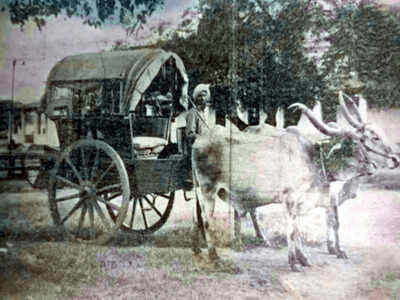
The Covid pandemic has disrupted life all over the world, and three week lockdown, despite being necessary, has created a set of problems of its own. There’s an aura of fear and paranoia in the atmosphere. But then, pandemics are not new to India. It’s just that advances in technology and hygiene have made us forget them.
It was August 11 of 1898 and a train of the Southern Mahratta Railway chugged into Bangalore Cantonment from Bombay via Hubli. A railway loco superintendent, followed by his butler, disembarked at the station. The railways had physical screening for plague as the illness had spread in Bombay presidency then, and a police constable would escort the passenger home to ascertain their residence and had to report for checks for 10 consecutive days. Similarly, railway staff realised that the butler showed symptoms of the epidemic. He goes into history as the first patient in Bangalore when he was confirmed with plague the following day and died on August 15, 1898.
British official PR Cadell’s Report on the Outbreak of Plague in Bangalore 1898-99 records this incident but also points to a train with grains halting at Bangalore city station around the same time. Authorities quarantined the load workers, 22 of them, to the good shed area (then Godownpet) to contain the disease. The approach seemed successful until September 9. After that, the plague went out of control, spreading rapidly to the Cottonpet and Akkipet areas. The Bangalore District Gazetteer of 1998 recorded the rapid rise of mortality in Bangalore from September 19 as 105 deaths per week. By October, 1,393 plague attacks were recorded and 2,807 died in the pete area alone. That December, the cantonment had 1547 casualties.
Dozen rats, three annas
The Bangalore yearly administration report of 1898-99 had recorded the government allotting Rs 2,45,790 as Plague Fund to control the epidemic and a Plague Commission being appointed. The municipality purchased 22 carts with 22 pairs of bullocks for Rs 2,565 and handed them over to new sweepers to remove dead bodies from drains, dustbins and even public toilets.
The Commission began supervising plague control and observation through special camps set up on Magadi Road, then on the city outskirts. Celebrations and festivals were cancelled, the Yeswantpur railway station was converted into a medical inspection spot for persons coming into the city. Persons showing mild symptoms of plague were quarantined in 588 sheds for a 10-day period with compulsory segregation. Handbills and notices spreading awareness and explaining symptoms of the epidemic were distributed on bullock carts. Drains were cleaned, 18,438 houses disinfected, 651 houses declared inhabitable demolished and 36,259 people inoculated as plague prevention.
Municipal authorities offered six annas for a dozen dead bandicoots, three annas for a dozen rats and two annas for a dozen mice - in an effort to reduce the rodent population, believed to be plague vectors. The reward remained in force till 1911.
Birth of Basavanagudi, Malleswaram
In 1896 as part of a city expansion plan, plots for sale were divided in Basavanagudi and Malleswaram layouts by local authorities. But there were hardly any takers. The plague epidemic in Bangalore drastically changed that with people who remained in the city during the spread moving to the two areas and pitching tents to escape the outbreak.
“People were desperate for good and spacious living conditions, fresh water and wider roads like never before after witnessing the rampant spread of plague in cramped Petta areas. Thereafter, Basavanagudi and the Malleswaram areas that were mostly open grounds were occupied by people later leading to the development of the localities,” said Suresh Moona, city historian and columnist.
Padmanabhan Palpu, a famous doctor and bacteriologist from Kerala, was posted as the first health officer for a monthly salary of Rs 400 during the plague outbreak. He played a key role in containing the spread in Bangalore. The Mysore Maharaja later felicitated Palpu for arduous service to state and he was instrumental in setting up the Victoria Hospital here.
It was August 11 of 1898 and a train of the Southern Mahratta Railway chugged into Bangalore Cantonment from Bombay via Hubli. A railway loco superintendent, followed by his butler, disembarked at the station. The railways had physical screening for plague as the illness had spread in Bombay presidency then, and a police constable would escort the passenger home to ascertain their residence and had to report for checks for 10 consecutive days. Similarly, railway staff realised that the butler showed symptoms of the epidemic. He goes into history as the first patient in Bangalore when he was confirmed with plague the following day and died on August 15, 1898.
British official PR Cadell’s Report on the Outbreak of Plague in Bangalore 1898-99 records this incident but also points to a train with grains halting at Bangalore city station around the same time. Authorities quarantined the load workers, 22 of them, to the good shed area (then Godownpet) to contain the disease. The approach seemed successful until September 9. After that, the plague went out of control, spreading rapidly to the Cottonpet and Akkipet areas. The Bangalore District Gazetteer of 1998 recorded the rapid rise of mortality in Bangalore from September 19 as 105 deaths per week. By October, 1,393 plague attacks were recorded and 2,807 died in the pete area alone. That December, the cantonment had 1547 casualties.
Dozen rats, three annas
The Bangalore yearly administration report of 1898-99 had recorded the government allotting Rs 2,45,790 as Plague Fund to control the epidemic and a Plague Commission being appointed. The municipality purchased 22 carts with 22 pairs of bullocks for Rs 2,565 and handed them over to new sweepers to remove dead bodies from drains, dustbins and even public toilets.
The Commission began supervising plague control and observation through special camps set up on Magadi Road, then on the city outskirts. Celebrations and festivals were cancelled, the Yeswantpur railway station was converted into a medical inspection spot for persons coming into the city. Persons showing mild symptoms of plague were quarantined in 588 sheds for a 10-day period with compulsory segregation. Handbills and notices spreading awareness and explaining symptoms of the epidemic were distributed on bullock carts. Drains were cleaned, 18,438 houses disinfected, 651 houses declared inhabitable demolished and 36,259 people inoculated as plague prevention.
Municipal authorities offered six annas for a dozen dead bandicoots, three annas for a dozen rats and two annas for a dozen mice - in an effort to reduce the rodent population, believed to be plague vectors. The reward remained in force till 1911.
Birth of Basavanagudi, Malleswaram
In 1896 as part of a city expansion plan, plots for sale were divided in Basavanagudi and Malleswaram layouts by local authorities. But there were hardly any takers. The plague epidemic in Bangalore drastically changed that with people who remained in the city during the spread moving to the two areas and pitching tents to escape the outbreak.
“People were desperate for good and spacious living conditions, fresh water and wider roads like never before after witnessing the rampant spread of plague in cramped Petta areas. Thereafter, Basavanagudi and the Malleswaram areas that were mostly open grounds were occupied by people later leading to the development of the localities,” said Suresh Moona, city historian and columnist.
Padmanabhan Palpu, a famous doctor and bacteriologist from Kerala, was posted as the first health officer for a monthly salary of Rs 400 during the plague outbreak. He played a key role in containing the spread in Bangalore. The Mysore Maharaja later felicitated Palpu for arduous service to state and he was instrumental in setting up the Victoria Hospital here.
Coronavirus outbreak
Trending Topics
LATEST VIDEOS
City
 Covid-19: Elderly man quarantined in boat in West Bengal's Malda
Covid-19: Elderly man quarantined in boat in West Bengal's Malda  COVID-19: 108 patients in national capital are Jamaat attendees, says Delhi CM Arvind Kejriwal
COVID-19: 108 patients in national capital are Jamaat attendees, says Delhi CM Arvind Kejriwal  9000 Tablighi Jamat workers and their contacts have been identified: Home Ministry
9000 Tablighi Jamat workers and their contacts have been identified: Home Ministry  Govt employee commits suicide over fear of Covid-19 in UP's Saharanpur
Govt employee commits suicide over fear of Covid-19 in UP's Saharanpur
More from TOI
Navbharat Times
Featured Today in Travel
Get the app





